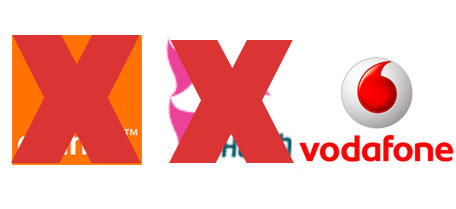Xbox 360 price cut is official

After a lot of denial Microsoft has finally announced the price cut of Xbox 360 in a bid to compete with the recent PS3 price cuts. The new price of the console for the premium edition would be $50 less to $350, Core at $280 which is $20 less and the Elite edition is priced at $450 which has got a $30 price cut.
This price cut is limited to US only.
Acer buys Gateway

Taiwanese computer maker, Acer has announced that they will acquire the third largest US PC maker, Gateway for a whopping sum of $710 million. Acer will buy all the shares of Gateway for a price of $1.90 which is 57% higher than Gateway’s closing price on Friday. This acquisition will make Acer the third largest PC maker in the world putting Lenovo in the fourth place.
J.W. Wang, Chairman of Acer:
This strategic transaction is an important milestone in Acer’s long history. The acquisition of Gateway and its strong brand immediately completes Acer’s global footprint, by strengthening our US presence. This will be an excellent addition to Acer’s already strong positions in Europe and Asia. Upon acquiring Gateway, we will further solidify our position as number three PC vendor globally.
The new Google Reader (with search)

I use Google Reader extensively. And as every day, I logged into my account only to find this message. Unfortunately I couldn’t try the new look as the link was not clickable in Opera. Anyone else got the same message?
If you haven’t noticed the screenshot, it now features a search bar too. Hit the more button for a larger view.
KeUpper helps you grow hair the hard way

Japan is the mecca of gadgets. Or I would rather put it as a mecca of quirky gadgets. The image you see above is a headphone resembling hair growing device. The KeUpper has to be worn as a headphone and the spikes sit on the head. Ouch! The spikes then magically do something to make your hair grow. It is surely a pain on the head as well as the pocket. It costs $1000.
Exciting Times for "Sharing and Social Networking"
The past few months have been busy for me and for my team. I took a long vacation back to Istanbul, giving me an opportunity to disconnect from my work and my blog for a while, and then came back to a new organization, a launch, and a very active Seattle.
As Moz recently summarized in an entry, we went through some reorganizations and the changes they brought. We seem to have settled into a new structure for now: product management and marketing roles have been more clearly delineated, while lines around our products have blurred. As most of you know, I have been working on the Spaces and Writer products for the past two years. In an effort to bring more seamless experiences to our customers in our next waves of planning, I will now be heading a new team focused on Sharing and Social Networking. Product management for a lot of the services you are familiar with, such as Spaces, Events, Writer, Photo Gallery, will now be run from my team, giving us a better view of your end-to-end sharing scenarios. Chris and Charlotte will be the managers on my team, as well as JP, a new product manager joining us to bring you better Memories experiences. My marketing leads like Marty, Marianna, and Pooja will continue to work on marketing, moving to the organizations running US and international execution.
In addition to the organizational changes, we have been busy building software. You probably saw the launch of Windows Live Events and a set of new features last week, especially the improved "What's New" section. Windows Live Photo Gallery also raised the bar with Flickr integration. I am excited with the stuff coming out but am painfully aware of how much we still have to do, in order to bring great experiences together.
I have been receiving a lot of questions lately about "Spaces' social networking" plans. Speculation around our partnerships have also led to the questions "isn't Spaces Microsoft's competitor to Facebook? What social scenarios are you thinking about?" While I cannot divulge any long term plans here, let me clarify one thing: "social networking" for us refers to the set of online experiences that allow users to feel connected with the people they care about. You did not see "Spaces" anywhere in there, did you? That is because I do not equate it with Microsoft's "social network." A lot of players have done a good job building profile networks --MySpace and Facebook most notably. I am a Facebook user (and Twitter, and MySpace, and a bunch of other things) and have a lot of respect for what they are doing. However, I do think that social scenarios will extend well beyond a "profile network," and defining social networking as a "website where I have a profile, friends, FoF, and some communities I share with" may be short sighted. Windows Live Messenger and Hotmail should become amazing social experiences. Our memories experience should tie in. Events and others
should become great social experiences, not to forget MSN. And all these things will be part of our "social networking" plans. Do not equate "what is Spaces doing" to "what is Microsoft doing" so quickly --and I do not think Facebook is thinking so narrowly either. We will continue to develop and improve Spaces of course, but we are trying to think broader to address your needs.
I will save writing about Istanbul to another day. I am excited to be back in Seattle, but I already miss home. Perhaps a good skiing season will lessen that feeling!
Thursday, October 18, 2007
Sandisk Sansa View PMP

Sandisk has rolled up its sleeves and unveiled Sansa View to take on the mighty iPod Nano. Just like the new Nano, this skinny player can play videos. Measuring just 8.8mm, Sansa View comes in capacities of 8GB or 16GB and boasts a 2.4-inch display (320X240 pixels). For the videos, it has proprietary software to convert the videos to be compatible with the player and on the audio front; it can play MP3/WMA/WAV files. There’s also a FM Tuner. A single charge can give around 35 hours of audio playback or 7 hours of video. And yea, if the built-in storage capacity is less for you, there’s also a support for microSDHC cards. Pretty neat!
The 8GB player will cost to $150 and 16GB at $200 which is also available on Amazon.
LG’s lightweight E200 series notebooks

Laptops are meant for carrying around. That’s what LG Electronics is trying to convey with its new X Note E200 notebook series. The exact specifications are not known but E200 will feature a 12” screen and it weighs just 1.8kg. LG managed to shove off extra pounds by including a detachable optical disk drive. Apart from that, the notebook is based on Intel’s Napa platform which means that it is 20% faster than the existing lot. It is priced at around $1500.
Hutch is now Vodafone

Hutch is facing an identity crisis again. Initially, it was known as Orange and then transformed itself to Hutch and from tomorrow, it will be recognized as Vodafone. That’s right. And this is being done because of the deal which took place between Vodafone and Hutch Essar in May 2007. Not only the name but the Pink Hutch logo, the lovely Pug dog all will be canned. Instead there will be the “Speech mark” logo used by Vodafone globally.
Though Hutch Vodafone is planning to go on advertising frenzy to unveil its new identity, it would be interesting how consumers react to this. It wouldn’t mean much to the existing users but can easily confuse the potential ones.
Palm unveils low cost Centro

Palm has finally announced its Centro device to be available from October 14 exclusively on Sprint network. Centro is till date Palm’s lightest and smallest smartphone. It runs on Palm OS and features a touchscreen display (320X320 pixels) along with a QWERTY keyboard making it ideal for messaging, web surfing and IMing. The phone also has a 1.3 megapixel camera, microSD expansion slot, music player, Google Maps and a bunch of Sprint apps.
It will come in two colors, Ruby Red and Onyx Black for a price of $100.
Sony Walkman A910 Series Players

Sony Corp. has announced a new Walkman series which will hit the Japanese shores in the first week of November. The A910 Walkman series has a large 2.4” display and plays music, video and also broadcasts TV (1Seg, Japan’s equivalent to DMB) and FM. There’s also an Electronic Programming Guide (EPG) which can help user to schedule upcoming TV shows and also record them.
As for the storage, it will come in 4, 8 or 16GB options and can play 36 hours of music, watch 6 hours of TV or record for 16 hours. Regarding the price: NW-A916 (4GB) for 30,000 Yen ($261), NW-A918 (8GB) for 35,000 Yen ($305) and NW-A919 (16GB) for 45,000 Yen ($392).
2mm thick USB Flash Drive

The basic function of all the flash drives is to store data. But there’s a distinguishing factor or rather the form factor of the drive which makes us to buy a particular one. A new flash drive in the rat race is from Freecom which is as sleek as your credit card making it the slimmest flash drive available in the market. Available in storage sizes from 256MB to 4GB, this can be ideal for those who often forget to pocket their flash drives pretty frequently.
Pricing starts from 23.49 Euros ($33) to 69.99 Euros ($100).
Gateway One PC

Taking some inspiration from the Cupertino giant, Gateway has unveiled a desktop PC somewhat equivalent to iMac. And looking at the picture, it surely looks amazing. Gateway’s One (that’s what it is named) boasts a 19-inch widescreen LCD and the 3.5” width of the case hides the whole machine easily behind the LCD. There will be two models up for sale starting from $1500, and depending upon the configuration the PC will include 1.5GHz or 2GHz Core 2 Duo processor, 2 or 3GB RAM, 320GB or 500GB HDD and Intel X3100 graphics card or ATI Radeon HD 2600 GPU.
AT&T Tilt

AT&T has announced a new phone dubbed as Tilt (8925). The phone is designed by HTC and features a 2.8” screen with a slide-out QWERTY keyboard and runs on latest Windows Mobile 6.0. Connectivity options include UMTS/HSDPA, Bluetooth 2.0 to connect up to six devices and Wi-Fi. There’s also GPS provided by TeleNav, push email, a cool 3 megapixel camera with autofocus and an expandable storage up to 32GB via microSD cards.
The phone is available from today at all AT&T stores at a price tag of $299.99 with a two year contract.
Aven miniVUE camera for microscopes

Aven Inc.’s new product will definitely help people doing microscopic studies. Their new offering called as miniVUE Digital Camera will enable the researchers to take live pictures and videos of minute species. As Aven says it is the world’s first digital color camera for microscopy and video inspection, it boasts a 3.1 megapixel camera to capture, a 2-inch LCD display and SD card support. Apart from mounting on the microscope, MiniVUE can be connected to USB or its images can be viewed on a larger screen with the TV Out feature.
Priced at $995.
Wednesday, October 17, 2007
Could Foleo, Based on Linux, Coupled with Google Gears, Become the Future of the PC?
I’m following a series of technologies that are coming to market to displace the aging PC concept. While Bill Gates and Steve Jobs clearly believe the rich PC, as a general use product, represents the best future, I’m no longer so sure. With Apple now being hit with Windows-like attacks and the clear realization that, from a security standpoint, it may be virtually impossible to protect any rich connected desktop client effectively, from an IT perspective, I’m beginning to wonder if it isn’t time for a major change.
This isn’t about changing from Windows to Apple or Linux. This is about rethinking the entire platform and designing it from the ground up so that the things you want to protect remain in more physically secure locations and nothing remains in the field that can’t be instantly deleted or rendered inaccessible.
The Smartphone Model
With the smartphone, in a few weeks, you’ll see the launch of a comprehensive security communications product that rivals RIM for ease of use, and is unmatched in terms of security, IT control, personalization, and capability for this class of device. For some time, we’ve had capabilities on smartphones that exceed what we had 10 years ago on laptop computers in terms of productivity and data access and this gap is closing incredibly fast.
But the issue with a smartphone is that physically it is both too small and too large. It is too small to be a useful computer for document creation, Web browsing or most forms. It is too large to be carried as a phone. This is why many BlackBerry and Treo users also carry smaller cell phones for calls.
But, ask yourself, short of video games, if you can open documents, create and show presentations, manage and create e-mail, search the Web, and even look at pictures and some video and can remain connected, do you truly need a laptop?
Cisco Executives in Brazil Jailed: Cause Could be Brazil Corruption not Cisco Wrongdoing
Cisco was just caught in a tax sting and a large number of executives, with little or no warning, were tossed in jail.
( Bloomberg reports the federal police Web site alleges the U.S. company and its Brazilian partners used offshore companies to evade import duties on networking hardware, evading roughly $824 million in taxes over five years.)
This may not be because Cisco did anything wrong but because the company didn’t give in to extortion, and we need to wait until all the facts are in. This serves as a reminder that having relatively uncorrupt law enforcement is one of the benefits of living in the United States that we probably take way too much for granted.
South America is known for having a heavy bribery and corruption problem, and even there Brazil stands out. I was an internal auditor for IBM when we had a problem there where an executive — and IBM had hard rules against this — was caught in a bribery scandal. It was clear at the time the executive was put in an unwinnable position and made a bad decision largely because he wasn’t given a good choice.
As a result, when I see something like the Cisco problem, I want to understand both sides of the story before I form an opinion. In areas where there is lots of corruption, not going to jail may have more to do with whom you bribe than anything you did or didn’t do. So we need to take a breath and hold for the facts.
U.S. Companies At Disadvantage
The problem is, U.S. companies are between a rock and a hard place in countries where bribery is common. If they don’t bribe, they get nailed to the wall by the local government, and if they do bribe, they get nailed to the wall by our government, making doing business in these countries incredibly risky.
For Cisco, even telling the whole story could be difficult because, in doing business in South America, it may have done some things unacceptable to U.S. law enforcement, making it incredibly hard to defend itself now.
Personally, I think it is probably better not to do business in countries that have this problem, or to work through independent third parties and not establish a presence there, rather than take this risk. In the end, this may be a cautionary tale for any company doing business in South America: The risks may exceed the benefits.
So to understand this, watch what happens next. If Cisco pays a large sum of money, then exits this market without criminal charges, chances are this was a failed attempt at extortion with a rather solid “or else.” If people go to jail and the U.S. Justice Department takes action, then Cisco has a more serious problem.
Wrapping Up
In the end though, I still believe we need a better way to deal with foreign corruption. Either we accept it as a price of doing business, which it is, or we don’t allow U.S. companies to enter these regions without much more U.S. protection.
Upsetting a U.S. multi-national during an election year could be a mistake for Brazil as well and give the Republicans a way to divert at least some attention from Iraq and Iran and onto something else, such as Cisco’s defense. Cisco is one of the most powerful companies in what is still a Super Power and if this doesn’t piss off the Cisco CEO, I’m not sure what will.
This isn’t to say Cisco didn’t do something wrong, but it is are entitled to the benefit of the doubt. And given it is Brazil, I have a lot of doubt.
Cisco has a reputation for being an honest company and this one event, given where it is, shouldn’t tarnish that before the facts are in. Let’s watch this one closely but not jump to conclusions before it is clear, if it ever is clear, who is truly in the wrong here.
Google To $2000/Share? Somebody Muzzle Blodget
 Henry Blodget made his name by predicting outlandish price increases for Internet stocks in the late nineties. A lot of people lost a lot of money (or, all their money) by listening
Henry Blodget made his name by predicting outlandish price increases for Internet stocks in the late nineties. A lot of people lost a lot of money (or, all their money) by listening to his recommendations. The government charged him with securities fraud in 2003 and he was subsequently banned from the securities industry for life.
to his recommendations. The government charged him with securities fraud in 2003 and he was subsequently banned from the securities industry for life.
But Blodget is a bit of a one trick pony, and he likes to stay in the headlines. So he continues build cases for big valuations of Internet companies. The only difference is he publishes these thoughts on his blogs. And people still listen to what he has to say.
to what he has to say.
He isn’t always bullish (he’s recently trashed Yahoo and eBay). But he can’t seem to contain his regular predictive outbursts that such-and-such stock is worth massively more than it is now.
When he’s talking about Facebook being worth $6-$20 billion that’s ok, because it isn’t a public stock and no one is going to go out and throw away their life savings. But when he builds a case for Google’s stock to go to $2,000/share, he’s crossing a line
that’s ok, because it isn’t a public stock and no one is going to go out and throw away their life savings. But when he builds a case for Google’s stock to go to $2,000/share, he’s crossing a line .
.
Remember a couple years back when some analyst floated the idea that Google could eventually be worth $2,000 a share–and was ridiculed from coast to coast? Well, first it’s worth noting that Google is now almost a third of the way there. Second, it’s worth noting that $2,000 a share would mean a market cap of about $750 billion, which–given a reasonable time horizon–just isn’t that far-fetched.
The problem is that Blodget, like all analysts, build authoritative sounding but essentially bullshit predictive models to back up whatever prediction they’ve just pulled out of their ass. When Blodget predicted a massive Amazon price increase in 1998, for example, he used three models
to back up whatever prediction they’ve just pulled out of their ass. When Blodget predicted a massive Amazon price increase in 1998, for example, he used three models : price to revenue multiples, revenue growth assumption, and an earnings multiple growth model. When you read it, it sounds like he really knows what he’s talking about. But he’s really just predicting future growth based on past growth and backing it up with a lot of smoke and mirrors. If the data doesn’t fit or doesn’t exist, a common trick is to use a competitor’s or analogous company’s data instead. One way or another, a model can be built around that headline grabbing prediction.
: price to revenue multiples, revenue growth assumption, and an earnings multiple growth model. When you read it, it sounds like he really knows what he’s talking about. But he’s really just predicting future growth based on past growth and backing it up with a lot of smoke and mirrors. If the data doesn’t fit or doesn’t exist, a common trick is to use a competitor’s or analogous company’s data instead. One way or another, a model can be built around that headline grabbing prediction.
Blodget builds his Google $2,000 prediction on similar models - in this case he talks about a multiple on free cash flow.
But market conditions change and these models just aren’t capable of taking that into consideration. Anything could derail Google’s current growth rates - a credit crunch, a housing collapse or a recession could all have a big impact on consumer spending and the advertising market, and impact Google massively. The market, over the long run, is fairly efficient at predicting the value of companies. If Google really was going to go to $2,000 per share, it would be priced there already, minus only a discount based on the time value of money. It isn’t, and so if you’re betting that Google is going to $2,000 that means you are betting against the market and all its participants. And all you have to go on are Blodget’s bullshit predictive models.
We are often criticized for being overly optimistic about young startups. That’s worth arguing over, but if we get it wrong at least we’re not moving the market. Venture capitalists do their own due diligence and don’t last long if they place too many incorrect bets. But when journalists start writing about public companies, stock prices can (and do) move, and people can lose a lot of money.
Blodget wants to stay in the headlines, but he has little concern for those that follow his advice. “If it doesn’t happen, don’t come whining to us,” he says in the Google post. That’s a disclaimer of sorts, but it also shows that he’s not all that interested in the fallout that may occur from his words. And if his past predictions are any indicator of Blodget’s ability to pick stocks, a fallout is almost certainly coming.
Update: Well, I sure was wrong. Blodget nails it in a new post valuing TechCrunch at a cool $100 million. My thoughts at Crunchnotes
valuing TechCrunch at a cool $100 million. My thoughts at Crunchnotes .
.
New Technorati CEO Has A Challenge Ahead
 Technorati today announced
Technorati today announced its search for a new CEO was over, with Richard Jalichandra being appointed to the role, some 6 weeks since Technorati’s founding CEO David Sifry stepped down and 5 months since it was publicly confirmed that Technorati was seeking a new CEO.
its search for a new CEO was over, with Richard Jalichandra being appointed to the role, some 6 weeks since Technorati’s founding CEO David Sifry stepped down and 5 months since it was publicly confirmed that Technorati was seeking a new CEO.
Prior to joining Technorati, Jalichandra held roles at Exponential Interactive, Fox Interactive Media and IGN Entertainment. Most recently Jalichandra was Entrepreneur-In-Residence at Battery Ventures, an advisory board member at MyYearbook.com and Pixsy, and as an M&A and strategy consultant for several other startups.
The once great Technorati has floundered in recent years as attempts to broaden its product offering resulted in its core blog search product suffering for lack of development and support, all at the same time that Google Blog Search came to the fore. More recently, Technorati started downsizing staff as the approx. $20 million raised over three rounds started to dry up.
has floundered in recent years as attempts to broaden its product offering resulted in its core blog search product suffering for lack of development and support, all at the same time that Google Blog Search came to the fore. More recently, Technorati started downsizing staff as the approx. $20 million raised over three rounds started to dry up.
As I’ve noted previously, I’ve always had a soft spot for Technorati. When I started blogging in 2002, the only way of tracking the blogosphere was Technorati and perhaps to a lesser extent Daypop, which was never as good. Jalichandra’s challenge will be to focus Technorati on achievable goals, whilst purging the company of the excesses of the past. Technorati’s failed Digg clone WTF (the most unfortunate acronym I’ve ever seen) should be the first to go. Core competencies in blog search, in particular with focus on filtering results from spam blogs must be a priority. Given the new competition from Techmeme on the popular blog list side, a more frequently updating service from Technorati should be on the to-do list, with perhaps more contextual lists; say popular blogs by vertical and filtered results based on link age, for example link popularity over 1, 3, 6, and 12 months, then maybe an all-time popular list would be nice.
If you’ve got any advice for Jalichandra on how Technorati can rise from the endangered list, let him know in the comments.
Yahoo Search Just Got Smarter

Yahoo is adding some major features to its search engine today. For instance, images from Flickr and playable videos are now embedded in the main results page. A search for a major rock band like U2
is adding some major features to its search engine today. For instance, images from Flickr and playable videos are now embedded in the main results page. A search for a major rock band like U2 brings up information from the artist’s Website, along with a list of songs that can be played as 30-second audio streams (courtesy of Yahoo Music).
brings up information from the artist’s Website, along with a list of songs that can be played as 30-second audio streams (courtesy of Yahoo Music).

Do a search for a restaurant or hotel, and results from Yahoo Local come out on top, with links to maps, ratings, and reviews. Type in “bourne ultimatum ,” and the top result is a widget from Yahoo Movies with a trailer you can click on, audience reviews, and show times nearest you. Search for “Vancouver
,” and the top result is a widget from Yahoo Movies with a trailer you can click on, audience reviews, and show times nearest you. Search for “Vancouver ,” and the top result is a widget from Yahoo Travel, with links to a guide, hotels, restaurants, flights, and maps. Type in “digital camera
,” and the top result is a widget from Yahoo Travel, with links to a guide, hotels, restaurants, flights, and maps. Type in “digital camera ,” and you get shortcut results from Yahoo Shopping.
,” and you get shortcut results from Yahoo Shopping.
Customized results also come up for searches dealing with health, sports, and events—all without you having to specify what type of search you are trying to do. Instead, Yahoo attempts to figure out your intent based on the search terms and the topics associated with them (Google espouses a similar Universal Search approach, as does Microsoft).
But the most important feature is an Ajax assistant pane that drops down when it detects you hesitating while typing in a search term. It gives you suggestions to complete the keywords, as well as related concepts that you might want to try. So if you type in “energy savings,” it suggests click-able links to related terms such as “energy star,” energy efficiency,” and “thermostats.” And this one is close to home for me. Type in “office sublets” and it suggests “small office sublets in new york city,” since Yahoo knows my zip code.
Yahoo has really nailed guided search with this release—as long as what you are looking for can be found somewhere else within Yahoo. That’s my one pet peeve about Yahoo’s new search upgrade. All of these shortcuts are helpful, but they are not all objective. Most of them (the search widgets, not the keyword assistant) point back to Yahoo.
More Adobe AIR Apps
 Lots of new Adobe AIR applications
Lots of new Adobe AIR applications are launching today at the Adobe Max conference in Chicago. In addition to those in the previous post, they include:
are launching today at the Adobe Max conference in Chicago. In addition to those in the previous post, they include:
—A new Adobe Media Player that lets you watch shows in Flash either online or off and manage your shows in an iTunes-like application. Videos from CBS, PBS, Yahoo Video, Blip.tv, Revision3, and others are available.
that lets you watch shows in Flash either online or off and manage your shows in an iTunes-like application. Videos from CBS, PBS, Yahoo Video, Blip.tv, Revision3, and others are available.
—A dedicated eBay Desktop for power eBay users.
for power eBay users.
—A desktop version of AOL’s Top 100 Videos .
.
—A video puzzle from Nickelodeon .
.
—Apps for Salesforce.com .
.
—A stock-market visualization app called Market Replay from Nasdaq .
.
To try most of these apps, you will have to install the latest version of Adobe AIR .
.
Developers who want to create AIR apps can get the second version of the beta, released today, here .
.
Plug To Be Finally Pulled On Findory
 Personalized newspaper service Findory is finally closing, after remaining on life support since January when development ceased.
Personalized newspaper service Findory is finally closing, after remaining on life support since January when development ceased.
Founder Greg Linden has now posted that the site will now be shut November 1.
Linden took the opportunity to preach the gospel of personalized news, despite Findory’s failure:
Some day, online newspapers will focus on your interests, building you your own unique, customized front page of news. Some day, search engines will learn from what you do to help you find what you need. Some day, your computer will adapt to your needs to help with the task at hand. Some day, information overload will be tamed.
Strangely, despite a fairly smart looking platform, there has been no apparent effort at selling the site and/ or backend; I would have thought an eBay exit would have suited the site well. Findory will now properly join the TechCrunch Deadpool.
Playyoo Offers Peek Of Its YouTube For Mobile Games
 London, England based Playyoo will today announce the launch of its Playyoo Game Contest and give a sneak preview of its community-based platform for mobile casual games at the Adobe MAX event in Chicago.
London, England based Playyoo will today announce the launch of its Playyoo Game Contest and give a sneak preview of its community-based platform for mobile casual games at the Adobe MAX event in Chicago.
The Playyoo Game Contest is open to independent mobile game developers using Adobe Flash Lite; prizes include cash and promotional goods. Winners will be selected by Playyoo members based on download popularity and user ratings as at February 28, 2008.
Officially launching in December, Playyoo will offer a sort of YouTube for a mobile gaming that offers free games for mobile phones, user-generated content, social interaction and personal expression. Features will include:
- A “Easy discovery and download process” that will allow mobile phone users to find games of interest through the Playyoo platform. The site will provide personalized recommendations based on each user’s preferences and those of friends.
- Game creation tools that will allow users with no experience to design their own games
- Social networking features that will allow developers and users who interact with others
Playyoo promises an interesting offering that in part seems to be a logical, interactive step forward from the tried and million times cloned YouTube model. Playyoo will compete directly against Greystripe, another company offering free mobile games, but with licensed product as opposed to UGC (see our previous coverage here). I suspect there will be room in the market for both models, the interesting part to watch will be seeing which model becomes the more popular over time.
Private BuyOut Of Ancestry.com For $300+ Million
 Spectrum Equity Investors has led a $300 million investment to acquire a majority interest in Provo Utah-based The Generations Network (the parent company of Ancestry.com, MyFamily.com and other sites) according to a source with knowledge of the deal.
Spectrum Equity Investors has led a $300 million investment to acquire a majority interest in Provo Utah-based The Generations Network (the parent company of Ancestry.com, MyFamily.com and other sites) according to a source with knowledge of the deal.
The Generations Network competes with a number of new Internet startups that we’ve recently covered. Its Ancestry.com site competes with Geni and MyHeritage. MyFamily.com competes with Story Of My Life, Our Story and others.
Geni’s last round of financing valued the company at $100 million. But none of those competing sites, or even all of those sites aggregated, have caused any financial pain yet for The Generations Network. The company is pulling in $150 million or so in yearly revenue and is hugely profitable according to our source.
This is a liquidity event for many or most of TGN’s shareholders, although it is apparently not a complete buyout. Employees and possibly some outside shareholders still have equity in the entity, which is almost certainly preparing for an IPO or other larger liquidity event.
The most recent Comscore data says TGN had 8.2 million unique worldwide visitors in August. They’ve raised $95 million to date, although the last round of financing was closed in 2001.
The company is not responding to requests for comment.
Ezmo: Another Online Music Application Nibbling At iTunes
 We’ve come a long way since the record industry sued MP3.com in 2000. Listening to copies of your digital music online is quickly becoming commonplace and Norway’s Ezmo is another web application helping push the trend.
We’ve come a long way since the record industry sued MP3.com in 2000. Listening to copies of your digital music online is quickly becoming commonplace and Norway’s Ezmo is another web application helping push the trend.
Ezmo, like Anywhere.FM, is a clone of iTunes on the web that just came to the United States. Their Flash based player lets you upload your music to the web, organize it into playlists, and share with your friends (just 10). Unlike Anywhere.FM, Ezmo lets you not only pull music from iTunes, but upload music from your Windows Media Player and Winamp music collections too. However, Anywhere.FM still wins out in my mind for the time being. I find it easier for me to use because its user interface stays truer to iTunes. Their buddy radio is also an easy way to consume new music on par with Last.FM. Ezmo only lets you share music with ten friends.
The two companies compete with a host of other online music locker/streaming services like Mp3tunes, Maestro, imeem, Streampad, Songbird, and MediaMasters.
However, as labels and artists free themselves from DRM, sites like these open up a way around iTunes’s stranglehold over digital music sales. DRM-free music is compatible with the extremely popular iPod, which could turn these sites into another point of sale for digital music on the device (unless they become free). Anywhere.FM has already let listeners buy songs they listen to through Amazon’s new digital downloads service. Add to that a compelling simplicity missing from older online sites (Yahoo Music, Rhapsody) and these might be the type of convenient services Ian Roger’s is looking for.

Weather Derivatives Provider WeatherBill Takes $12.5 Million More
 San Francisco-based weather insurance site WeatherBill has taken $12.5 million in a round led by New Enterprise Associates and Index Ventures. Original investors Allen & Company, Atomico Investments (Skype founder Niklas Zennstrom), del.icio.us founder Joshua Schachter and Howard Morgan also participated.
San Francisco-based weather insurance site WeatherBill has taken $12.5 million in a round led by New Enterprise Associates and Index Ventures. Original investors Allen & Company, Atomico Investments (Skype founder Niklas Zennstrom), del.icio.us founder Joshua Schachter and Howard Morgan also participated.
Barney Schauble, a partner at Nephila Capital and WeatherBill’s risk capacity partner, will join WeatherBill’s Board of Directors. Total funding for Weatherbill to date is now $16.5 million.
WeatherBill was founded by former Googler David Friedberg. The company offers weather insurance policies to businesses - such as ski resorts, farms, airlines, construction companies, and amusement parks - with more than $1 million in net worth that have suffered losses due to unfavorable weather in the past.

Users choose a weather station via a Google Maps mashup and choose whether you want it to pay out for each hot, cold, rainy or dry day. Temperatures are set by the user by degrees and precipitation by inches.
WeatherBill hedges their own risk via their weather algorithm and also sells their risk on the back end to a number of hedge funds, in theory delivering a guaranteed profit regardless of the weather.
CEO David Friedberg says that Weatherbill has hundreds of customers and faces such high demand that it needs to bring more people aboard to increase capacity. The site has launched not only in the US but Canada, the UK, the Netherlands, Spain, Germany, and Norway as well.
If Only Users Were Gold: Skype Hits 10M Simultaneous Users Mark
Skypehas some more encouraging news following yesterday’s announcement that it has teamed up with MySpace to provide that social network’s users with free Skype calls.
Early this morning, 10 million users were connected to the Skype global network at the same time. That’s a tenfold increase over their celebration on October 20, 2004 of having 1 million simultaneous users.
However, in light of the recent bad news concerning the state of Skype, you may want to hold the applause and remember that lots of users don’t always translate into lots of money.
that lots of users don’t always translate into lots of money.

Monday, October 15, 2007
Google vs Facebook

Some Google employees are leaving Google for social site Facebook. Well, “some” isn’t a trend, but a couple of the remarks of those that left offer insightful perspectives. Pedram Keyani, who the Google System blog reported to have left Orkut in favor of Facebok (along with, as of recent times, Justin Rosenstein and Benjamin Ling) says, “I have the same kind of excitement about work that I had early on at Google. I can get lots and lots done and the only thing slowing me down is how quickly I can go.”
I was wondering, what exactly is slowing down some people at Google, and are those factors more than just the price to pay for managing that many employees? Some stuff like Google Presentations was in a bit of an announce-early-release-late kind of mode we are more used to from Microsoft. And at times, internal product evolutions are changed or halted, and another outside service is bought instead (think Google Video, which was replaced by YouTube as Google’s community video hosting site of choice, perhaps being part of the reason why Google Video director Jennifer Feikin left the company in May). Then again, judging from what Google China released just this year, movement is still very fast in at least some departments around the globe. There’s even some downright pirate hacker spirit going over in Beijing HQ, it seems.
Now Valleywag’s Paul Boutin follows up with a quote from Jason McCabe Calacanis at a discussion in front of a crowd interested in Facebook issues. Paul says Jason, the guy who sold blog network Weblogs Inc. to AOL, went into a “Pacino-esque monologue.” Here’s what he said (with some emphasis):
Social networking is second only to chat rooms as being the lowest CPM, the worst place to advertise... that’s not gonna change. And the reason for that – and this has nothing to do with Facebook, MySpace has the same problems – the reason is the content of your friends and family is more compelling than any advertisement will be.
This is why the comments in the last panel were so foolish about it being so competitive to Google, because Google has the greatest advertising in the history of media ever created... which is search advertising. When you type a word into the box, we know what you’re looking for.
When you’re on Facebook, we know you’re looking to meet a girl or a guy, or talk to your friends or your family. It’s a terrible platform to advertise, it always will be. It will always be low CPM, but high page views that make it up in volume. It’s a terrible, terrible way to make money.
Faced with arguments from another panel member that on social networks, you would buy something because someone else said they bought it and that it’s cool, Jason replies, “The holy grail of ecommerce, people have been talking about this forever... and it has not arrived.” Jason adds that the kind of advertising going on at Facebook is also a very low-margin business “nowhere near search inventory."
Then again, back in 1999, even Google didn’t have the best business plan in the world – in fact, they didn’t have any at all, according to statements made by the Google founders back in the days. Here’s ZDNet news in June 1999 (my emphasis):
When asked how the company plans to make money, Google CEO and co-founder Larry Page would only say what they won’t do. They don’t want to become a portal. No content. And they want to avoid competing with other search engines to be the browser of choice for existing portals. In fact, Page said Google doesn’t have any real competitors at all, which may be why they don’t intend to do much marketing.
But even Internet companies, which are almost expected to lose gobs of money, need at least a revenue stream, don’t they?
“We have other ways of making money,” said Page. “You’ll see.”
Google Apps - Premier Edition

From the You-Know-When-Ajax-Has-Gone-Mainstream-Dept, Google announced today it will be offering businesses a premium service for its key productivity applications, at $50/user/year. The package includes:
- Access to office-style applications - Google Docs & Spreadsheets, Google Page Creator. No presentation package yet - perhaps Google should acquire S5 :-).
- Access to communication applications - GMail (@your-own-domain), Google Calendar, Google Talk (voice/IM).
- Access to Google Homepage (maybe corporations could deck this out to become their intranet homepage?)
- Control panel to manage the domain
- Ads can be turned off
- Storage at 10GB/user
- Integration with organisation’s sign-on and email infrastructure
- Phone support
The apps themselves are available to anyone, but the integration and extra services come with the premium service. Google provides this comparison table.
The giant elephant in this room is your company’s data sitting on Google’s servers. In the absence of an “Apps Appliance” sitting inside the firewall, there will always be a major proportion of the market unwilling to commit to a solution like this - increased risk of data loss, theft, and manipulation. Google’s pure-external model keeps things nice and simple, but it’s not for everyone.
Zoho, for example, offers “in-premise edition” to run inside an organization’s network. Similarly, Zimbra’s collaboration app. It’s also becoming possible to make your own stack, with apps like Wikicalc and the various wikis, though nothing as comprehensive as Google’s offering. It’s feasible MS will move their apps in that direction too.
The comparison among these approaches will be worth watching in coming months. For now, though, it’s great to see how much Ajax and the web has evolved in the past two years, with Google providing a lot of the inspiration. From TechCrunch: “Beyond competition and concerns, tonight is a good time to recognize the incredible force of innovation that Google is as well. Its nearly full-service suite of sophisticated, integrated online services is something of historic proportion.”
Blogger & Podcaster

Once you setup an account you can add your blogs & podcasts to their free directory (B & P Guide). Not real sure why only three of the four I added are listed. As there aren't tons in the list, I am guessing I must be one of the early ones to get to their site and grab an online copy of Blogger & Podcaster.
Brangelina Triangle Tragedy: Marriage Vows Don't Count
 One of the things we know for sure in life is that nothing just happens. Science bears out this point with a well-established, immutable law of cause and effect. So, to hear Angelina Jolie play the "it-just-happened” card in a recent interview for the January 2007 issue of Vogue magazine to explain how her relationship with Brad Pitt evolved on the movie set of Mr. and Mrs. Smith, while he was still married to "best friend," Jennifer Aniston, was very disappointing. Ms. Jolie's moral and ethical conscience appears, at times, to be otherwise alive and well, as witnessed by her stance on several global sociopolitical issues. Therefore, as difficult as it might have been for Ms. Jolie to speak truth on this matter, we would have had a lot more respect for her honesty—and thought her interview less disingenuous—to hear her readily admit, without excuses, that she coveted Ms. Aniston's husband, and that they both suffered moral failure in doing the honorable thing, which would have been to walk away from each other—for good—with their integrity in tact. But then again, her later comments during a press junket for her most recent movie, The Good Shepherd, make it obvious that Ms. Jolie is still in denial (or believes we are) with respect to her actions. Moreover, with a “best friend” like Mr. Pitt, who needs enemies?
One of the things we know for sure in life is that nothing just happens. Science bears out this point with a well-established, immutable law of cause and effect. So, to hear Angelina Jolie play the "it-just-happened” card in a recent interview for the January 2007 issue of Vogue magazine to explain how her relationship with Brad Pitt evolved on the movie set of Mr. and Mrs. Smith, while he was still married to "best friend," Jennifer Aniston, was very disappointing. Ms. Jolie's moral and ethical conscience appears, at times, to be otherwise alive and well, as witnessed by her stance on several global sociopolitical issues. Therefore, as difficult as it might have been for Ms. Jolie to speak truth on this matter, we would have had a lot more respect for her honesty—and thought her interview less disingenuous—to hear her readily admit, without excuses, that she coveted Ms. Aniston's husband, and that they both suffered moral failure in doing the honorable thing, which would have been to walk away from each other—for good—with their integrity in tact. But then again, her later comments during a press junket for her most recent movie, The Good Shepherd, make it obvious that Ms. Jolie is still in denial (or believes we are) with respect to her actions. Moreover, with a “best friend” like Mr. Pitt, who needs enemies?Indeed, it is one thing for Mr. Pitt to walk out on his marriage to “best friend” Aniston, leaving her for another woman. But it has to be quite another for him to do so, while publicly declaring, “The idea that marriage has to be for all time—that I don’t understand.” One would have reasoned intelligently that this issue was settled at the “till death us do part” portion of their wedding vows. But, why stop there? To add insult to injury, Pitt, whether through his tacit or explicit agreement, effectively enabled his live-in lover, Jolie—who gave birth to their love child before the ink had dried appropriately on his divorce decree from "best friend," Aniston—to grant the interview and photo spread to Vogue to extol the virtues of their domestic bliss, plus throw out a public offer to Aniston for a truce, in such a manner that dared Aniston to look less than magnanimous if she refused. What a guy, sorry, “best friend”!
No one ever rightly promised that our choices in life were going to be easy. But, isn't the real mark of a person's character displayed in the choices made at those times when he or she is most tempted to pursue less-than-honorable acts? Too often, today, in our culture, “it-just-happened” is expected to explain away and justify ill-conceived behaviors, and the oft disastrous consequences of our choices, as if we were impotent bystanders in our own lives, and the consequences of our actions just crept up and overwhelmed us. However, we maintain that part of maturity—and integrity—is learning to accept the fact that we are equally responsible for the good things in life that "happen" to us, as much as we are for the bad, and the truth is we are enticed into action by our own desires.
In this same regard, then, it would be entirely unfair to say that we believe this sorry state of affairs "just happened" to Ms. Aniston. No doubt, there were choices made on both sides that ultimately precipitated the sad sequence of events. But, please, let us not miss the real issue in this unfolding saga…and it’s not about Pitt, Aniston, or Jolie, and whatever demons they did or did not struggle with. Ultimately, this sordid affair—and how the public has responded to the unfolding saga—is symptomatic of how we, as a culture, have come to value or devalue marriage. Betsy Hart’s recent commentary on the Jolie Vogue interview is right on the money, and we are glad this syndicated columnist had the courage to speak up about what’s really at stake. Indeed, Ms. Hart urges us to consider what these players have revealed about our culture's view of marriage: Marriage has largely become an "as long as I'm happy in the moment" idea.
To be sure, couples ought, rightfully, contemplate the point of making the promise "to love and to cherish as long as we both shall live," especially if it is being made without considered regard to its real cost. Marriage is a lifetime commitment. And, this has always been, and will continue to be, the watershed issue within marriage. But more importantly, what is to become of us as a society when we have become so shallow, and so twisted in our belief system, that adultery, cohabitation, and the like are simply par for the course, and we glorify and deem those who indulge in these illicit pursuits among the most beautiful people, and as the most beautiful family in the world?
Ms. Hart is right. What a tragedy.
Can it be any wonder then, why, through sheer organics, there appears to be a changing of the guard within the bastions of the media? Recently, the UK’s Guardian's Observer Magazine published an expose on Arianna Huffington of The Huffington Post, entitled Hurricane Arianna, and we urge you to read it. Author Paul Harris describes Ms. Huffington as “the Blackberry-toting, Bush-baiting Queen of the Blogosphere who has made her two-year-old website the most potent force in American politics." But more noteworthy than the awe-struck sycophancy afforded Ms. Huffington in the piece, is the growing recognition being given to the shifting balance of power within the media landscape. To be sure, the cost of setting up digital space now makes it more attainable for just about anyone to have a voice. Setting up The Huffington Post was cited to cost just $2 million, compared to a magazine, which might cost a publishing company like Time Inc. 20 times that to start up, yet reach a mere fraction of the audience currently logging on to the Post. But, there is no doubting its influence. What’s more, until the advent of the Internet, the mainstream media largely represented the "good 'ole boys club," and political cronyism at its worst, and the fact is a mere few—typically, those with money—controlled public opinion. Much worse, however, was the fact that the general public failed to grasp just how much these privileged few influenced their perception of truth. And, without a doubt, Time magazine's choice for Person of the Year: You (Yes, you. You, who control the Information Age) is a sign of the times.
Blogs are really what made this award possible. They may not be as well edited, researched, or even as well written as print journalism, but, ultimately, they could serve democracy—and the pursuit of truth—better...and, to be sure, you don't have to haul them down to the recycling bin when you're done! Sites like The Huffington Post, featuring up-to-the-minute news and blogs from a vast array of world-class writers, are making newspapers and weekly news magazines like Time and Newsweek obsolete. In like manner, celebrity Internet sites like PerezHilton, pushing the limits of decency and what is considered ethical in our society today, are challenging the very existence of their equivalent print rivals. But, we have little sympathy for the old media. Why? Because they created the monster that made ordinary people rise up and demand to speak for themselves. For too long, they have monopolized the airwaves and newsstands, with viewpoints that demonstrate we can be educated beyond our intelligence, yet still fundamentally lacking in wisdom. For too long, they have stalked celebrity "victims" as if they were prey, unwilling to pull in the reins of decency regarding what enquiring minds needed to know. For too long, they have damaged the public perception of truth. And, indeed, much of the old media needs to be challenged with respect to what it now purveys as journalism…or be knocked from its pedestal.
So, congratulations to you too, then, on being Time’s Person of the Year. This is great. Now, even sexual predators can tell the Monsignor in their next job interview that they were Time magazine's Person of the Year.
Gün Batımı - (evening) sinema

Gösterim Tarihi: 12 Ekim 2007
Yönetmen: Lajos Koltai
Oyuncular: Meryl Streep , Patrick Wilson, Glenn Close, Toni Collette
Senaryo: Susan Minot, Michael Cunningham
Müzik: Jan A. P. Kaczmarek
Görüntü Yön: Gyula Pados
Tür: Dram
Süre: 117 Dk.
Yapım Yılı: 2007
Ülke: ABD
Dağıtımcı: Bir Film
Hatıraların gücüne yenik düşen Ann Lord (Ms Rdgrave) kızları evli ve çocuk sahibi Constance (Ms Richardson) ile bekar biri olan Nina (Toni Collette)’e uzun zamandır sakladığı bir sırrını anlatır. Ann kimseyi sevmediği kadar bir adamı sevdiğinden bahsettiğinde ikisi de yatağın baş ucundadır.
Ama kimdir bu “Haris”, kızlar annelerinin bu adamla ne yaşadığını merak etmişlerdir. Constance ve Nina Ann’in ve kendi yaşamlarının sırlarını anlamaya çalışırken anneleri de zihninde elli sene önceki bir yaz hafta sonuna Ann Grant (Claire Danes) olduğu zamanlara döner.
Son Ültimatom Sinema

Gösterim Tarihi: 12 Ekim 2007
Yönetmen: Paul Greengrass
Oyuncular: Matt Damon , David Strathairn, Paddy Considine, Julia Stiles
Senaryo: Tony Gilroy, Robert Ludlum
Müzik: John Powell
Görüntü Yön: Oliver Wood
Tür: Almanya-İngiltere-ABD
Süre: 111 Dk.
Yapım Yılı: 2007
Ülke: ABD
Dağıtımcı: UIP Filmcilik
Jason Bourne’in tek isteği ortadan kaybolmaktır. Ancak kaybolmayı başaramadığı gibi kendisini yaratanlar tarafından ele geçirilir. Hafızasını ve sevdiği tek insanı kaybetmiş olan Jason Bourne, iyi eğitimli yeni kuşak katillerin yoğun ateşi altındadır. Artık sadece tek bir hedefi vardır: Başlangıca dönmek ve kendisinin kim olduğunu bulmak.
Casusluk-gerilim serisinin yeni bölümünde Jason Bourne (Matt Damon), yeni bir gelecek bulabilmek için kendi geçmişindeki izleri yakalamaya çalışır. Gerçek Jason Bourne’i bulma çabasına devam ederken Moskova’dan Paris, Londra, Tanca (Fas) ve New York’a uzanan geniş bir alanda seyahat etmek; sürekli manevralarla her an ensesinde olan yüzlerce polisi, federal ajanları ve Interpol ajanlarını safdışı etmek zorundadır.
Google Docs Partly Down Today

Google Docs is having some problems today, at least for some of us. Tadeusz earlier today reported he saw a 404 page at Google Docs. When I logged in, I received the message “The server encountered an error. Please try again later.” Then later, it started to work fine, but just now when opening a document I got the following message:
Sorry, but document editing is temporarily unavailable.
While we are working to restore the service, you can still view your documents – just not edit them. If you check back in a few minutes, editing will likely be available again.
[Thanks Tadeusz!]
Google Vanity Ring and More

Created by Markus Kison of Berlin University for Digital Media, the VanityRing displays the Google page count the wearer gets for their own name. It’s the ultimate status symbol but updated for the 2000s, beating even costly jewels. “Being in people’s mind means being important,” Markus says.

To raise your Google status even more, there are two new options from the Google store: Google lip balm and Google Rubik’s cube.
[Top link & pic via Digg and Manoj. Top image by Markus, second image by Google Store.]
Websites May Require Visually Impaired Access In California

California may require websites to provide access to visually impaired users under ruling made in the long running case of the National Federation of the Blind vs Target.
The case centers on Target not providing basic accessibility to vision impaired users via the use of alt tags for images, keyboard options for navigation and missing navigation headers.
US District Judge Marilyn Hall Patel in the Court for the Northern District of California had previously found that “the inaccessibility of Target.com impeded full and equal enjoyment of goods and services offered in Target stores” and has now ruled that the case is eligible for class action status, despite attempts by Target to have the case thrown out.
The result of the case will have far broader implications for the many startups and Web 2.0 companies operating in California, with many sites having to factor access into their services and sites or risk the prospect of legal sanctions.
Whilst the basics as easy enough: tagging images and making sure that sites can be accessed through text based browsers, the use of Ajax and other means of scripting sites means that the traditional html tagging may not either be available, or more difficult to implement.
There is some suggestion from the court case that accessibility may also be required under the Americans with Disabilities Act as well, meaning that although the ruling is currently focused on California law, it could extend to the rest of the United States.
More information on making websites accessible to those with visual impairments can be found at the American Foundation for the Blind.
Top Blogs On Google Reader
So Google recently made it fairly easy to determine the number of Google Reader subscribers around a particular blog. Gabe Rivera at Techmeme did a little work on excel and came up with an unofficial list of the top blogs and the number of subscribers each blog has on Google Reader. He sent the list around to people for comments - with his permission we’ve published it below.
This isn’t perfect because you have to think of the blog and then do a search for the stats; so some blogs may be left off. Also, some of these stats are aggregate numbers from different feeds for the same blog.
If you see errors or blogs that should be added, please point them out and we’ll correct them. It would also be good to round this out to a top 100 list and compare it to Technorati and TechMeme Leaderboard . Hopefully, Google will just publish this data themselves at some point.
The blog or other news site is listed on the left. Total Google Reader subscribers is listed in the second column.
Sunday, October 14, 2007
Are Good Security and Web 2.0 Incompatible?
There are far too many numbers in this TechNewsWorld story, which reports results of a survey on Web 2.0 threats conducted by Forrester Research for Secure Computing. The survey, released in conjunction with the introduction of the vendor’s Secure Web 2.0 Anti-Threat (SWAT) initiative, shows that IT folks are unaware, untrained and don’t have consistent policies for this dangerous and increasingly popular way to use the Internet. SWAT aims to raise awareness of the issues, offer tips and in other ways help companies protect themselves.
The story quickly devolves into a sea of percentages. The saving grace is that the big picture is aptly summed up by Ken Rutsky, Secure’s executive vice president of product marketing:
The report reveals a security blind spot. Some 90 percent of enterprise organizations are still deploying security measures designed for the last generation of attacks.
This Computerworld piece uses data — thankfully, more selectively — from what appears to be a different Forrester survey. The piece focuses on the initial reluctance, and now apparent grudging acceptance, of Web 2.0 by IT. Like wireless and other emerging technologies, IT ultimately must bend simply because the folks they serve are using the new approach.
The piece features several short and interesting vignettes on different companies’ approaches and offers eight steps for Web 2.0 proponents to take in order to implement a secure and beneficial platform. They should create awareness; find supporters in the company; get IT on their side and present a proposal to senior management. Web 2.0 fans also should work closely with business units; compile and distribute best practices; resist the urge to force adoption and be patient. IT, for its part, is well advised to seek and create alliances with Web 2.0 proponents who are wise enough to take up these procedures.
In a related story, Computerworld reports on comments by Christian Christiansen, an IDC analyst, at a recent Kaspersky Lab’s conference on cybercrime. Christiansen identifies two overlapping threats to corporate security. The line between employees’ online personal and business lives is increasingly porous. At the same time, employees don’t follow their employers’ security policies — probably because they don’t know what they are. The bottom line is that all sorts of things people do at work and at home — including the connection of untested devices and the use of possibly malevolent Web 2.0 sites — can compromise security.
Those seeking more specifics about the threats — the statement that “Web 2.0 is dangerous” is as nebulous as it is threatening — should look at video. vnunet.com says that Chris Rouland, the CTO of IBM’s Internet Security Systems (ISS), made a presentation at the annual summit of the George Tech Information Security Center in which he suggested that video may be the next big target.
More sophisticated Web 2.0 networks hide less fully developed applications and devices that are latent or active threats to security, according to this piece at eChannelLine. The writer, using research from WatchGuard, maintains that the placement of servers running collaboration, VoIP and other advanced services in data centers heightens the risks. These servers are not as mature as older applications and are therefore more vulnerable to clever hackers. This, combined with the fact that the goal is to create more open and interactive networks, means there are more opportunity for hackers.
ZDNet Australia uses the subpoena of Facebook by the Attorney General of New York State for failing to adequately protect young subscribers as a jumping off point for a look at consumer use of Web 2.0 applications. This is an important issue for IT security staffs because it is a given that employees will use consumer services for work purposes or, at least, on the same devices they use in their jobs.
These social sites often are free in exchange for permission to use tracking and data aggregation tools. The problem is a microcosm of Web 2.0 in general: What the site is trying to achieve involves actions or policies that are the exact opposite of good security practice.
Facebook released FBJS
Marcel Laverdet of Facebook blogged about the release of FBJS 1.0:
If you are already used to Javascript, you will find that most of the syntax and functionality that you have come to know and love (or hate) is available in FBJS. Additionally, we’ve created hooks into our higher-level AJAX and dialog implementations which allow you to easily create dynamic experiences while maintaining the look and feel of Facebook.
We hope that FBJS enables you to build deeply integrated Facebook Platform applications in new and interesting ways.
FBJS does munging on the JavaScript that you provide, as it tries to stop naughty things.
With respect to Ajax, they give you an object to work with that sits on top of XHR, and is proxied by Facebook servers:
FBJS supplies a very powerful AJAX object for developers. Facebook will proxy all AJAX requests and optionally run useful post-processing on the data returned, such as JSON, or FBML parsing. To use it, just instantiate a new Ajax class. It supports the following properties:
- ondone(data)
- An event handler which fires when an AJAX call returns. Depending on .responseType, data will either be an object, a raw string, or an FBML string.
- onerror
- An event handler which fires when an error occurs during an AJAX call
- requireLogin
- If you set this to true the AJAX call will require the user to be logged into your application before the AJAX call will go through. The AJAX call will then be made with the regular fb_sig parameters containing the user’s identity. If they refuse to login, the AJAX call will fail.
- responseType
- This can be one of Ajax.RAW, Ajax.JSON, or Ajax.FBML.
- Ajax.RAW
- The response from your server will be returned to your callback in its original form.
- Ajax.JSON
- The response from your server will be parsed as a JSON object and returned to your callback in the form of an object. Properties of your JSON object which are prefixed with “fbml_” will be parsed as individual FBML strings and returned as FBML blocks. These blocks can used on a DOM object with the setInnerFBML method.
- Ajax.FBML
- The response from your server will be parsed as FBML and returned as an FBML block. This block can used on a DOM object with the setInnerFBML method.
And one method:
- post(url, query)
- Start an AJAX post. url must be a remote address, and query can be either a string or an object which will be automatically converted to a string.
Here’s an example showing most of the functionality of Ajax:
Ajax Example
It is interesting to see more and more platforms wanting to open up and give users more abilities, but keeping the balance wrt security, privacy, and general abuse.
There are also rumors of new functionality to come, such as a data storage API.
Bill Gates on Web Apps
If you’ve read any tech news in the past 24 hours, you’ll now be familiar with the meeting Bill Gates held among influential bloggers, ahead of next year’s Mix conference. Aside from learning what’s on Bill’s Zune, we get to hear his views on the future of web apps, thanks to a question from Liz Gannes. She asked him which apps should live in the browser and which should not, one of the key questions in Ajax and one we have touched on in the past.
He replied that the distinction would come to be silly from a technical standpoint, but that the necessary movement toward web APIs does present challenges on the business side. “One of the things that’s actually held the industry back on this is, if you have an advertising business model, then you don’t want to expose your capabilities as a web service, because somebody would use that web service without plastering your ad up next to the thing.”
His solution wasn’t very specific: "It’s ideal if you get business models that don’t force someone to say ‘no, we won’t give you that service unless you display something right there on that home page.”
Then for the tease: “And, you know, [inside the browser and outside the browser are] moving towards each other, but there’s still a bit of a barrier there, and new technology, things we’re working on, really will change that.”
Making JavaScript Safe with Google Caja
Douglas Crockford continues to bang the drum for securing JavaScript in his latest post:
It is possible to make secure programming languages. Most language designers do not consider that possibility. JavaScript’s biggest weakness is that it is not secure. That puts JavaScript in very good company, but it puts web developers in an untenable position because they cannot build secure applications in an insecure language. JavaScript is currently going through a redesign that is again failing to consider the security of the language. The new language will be bigger and more complex, which will make it even harder to reason about its security. I hope that that redesign will be abandoned.
A more fruitful approach is to remove insecurity from the language. JavaScript is most easily improved by removing defective features. I am aware of two approaches that allow us to build secure applications by subsetting the insecure language.
The first approach is to use a verifier. That is how ADsafe works. A verifier statically analyzes a program, and certifies that the program does not use any of the unsafe features of the language. This does not guarantee that the program is safe, but it makes it possible to make programs that are safe. Any program can compromise its own security. The improvement here is that a program’s security is not compromised by the language it is written in.
The second approach is to use a transformer. A transformer verifies, but it also modifies the program, adding indirection and runtime checks. The advantage of transformers is that they allow the use of a larger subset of the language. For example, ADsafe does not allow the use of the this parameter. A transformer can allow this because it can inject code around it and its uses to ensure that it is never used unsafely. The benefit is that it is more likely that existing programs could run in a safe mode with little or no modification. I think that is a dubious benefit because programs that are not designed to be safe probably are not. The downside is that the final program will be bigger and slower, and debugging on the transformed program will be more difficult.
Both approaches work. But we still need to fix the browser.
A new project, Google Caja, is trying to do source-to-source translation to secure things:
Using Caja, web apps can safely allow scripts in third party content.
The computer industry has only one significant success enabling documents to carry active content safely: scripts in web pages. Normal users regularly browse untrusted sites with Javascript turned on. Modulo browser bugs and phishing, they mostly remain safe. But even though web apps build on this success, they fail to provide its power. Web apps generally remove scripts from third party content, reducing content to passive data. Examples include webmail, groups, blogs, chat, docs and spreadsheets, wikis, and more.
Were scripts in an object-capability language, web apps could provide active content safely, simply, and flexibly. Surprisingly, this is possible within existing web standards. Caja represents our discovery that a subset of Javascript is an object-capability language.
FBJS is also trying to do some of this too. Got some time on Friday to look around some code? Take a look at some Caja.
HP vs. Apple vs. RIM and Microsoft/Cisco Convergence: Battle for the Corporate Phone
I first started in tech with a PBX vendor, arguably the most advanced of its time. One of my positions there was as competitive analyst for phones, and I was able to use prototype devices that were vastly more advanced than anything anyone had ever seen.
Since then, I’ve been in major withdrawal, as these features and phones never made it to most desktops. Most folks are lucky if they can figure out how to do things like conference in a co-worker or transfer a call successfully.
This is a long way of saying the telephony industry doesn’t operate at “Internet speeds.” In fact, changes still seem to take decades — or at least did. That is about to change dramatically.
There are two types of convergence going on. The first is being largely driven by Microsoft, which is the only vendor possibly strong enough (and note I said possibly) to drive common standards across the telephony industry for user features. If it weren’t for Cisco, I’d lay odds it would fail, but Cisco is also a game-changer representing the greatest threat the legacy PBX vendors have faced since IBM, before it failed in this industry. And, unlike IBM, Cisco isn’t learning on the job and has what I believe to be the strongest enterprise VoIP solution in the segment.
The second is the convergence of cell and land-line phones. Northern Telecom tried and failed to do this more than a decade ago, but the technology wasn’t ready, and Northern didn’t have the breadth to make it work. With the surge on smartphones driven by RIM and Apple, coupled with the capability of HP, which just entered the segment with the strongest enterprise cell-phone line, the next step of converging PBX and cell services is closer than it has ever been.
Microsoft Background:
This is the fourth time Microsoft has made a run at phones. In the early ’90s there was a joke phone created by Microsoft Europe that floated around for a while. A consumer phone followed, one that depended on Windows 95 for features and was probably the worst telephone I’d ever seen in my life. After NT came out, a number of small PBX vendors used that platform in an embedded-like form and created what were the most reliable Windows Servers of their time (something that surprised most of us).
This is only to show that Microsoft’s experience here tracks back over a decade into both devices and switches, and while the results have been mixed, the company has an established knowledge base.
It’s also interesting that Microsoft itself used the cheapest and most limited phone systems in the market for much of its existence, and that likely motivated the company to create a solution that it could use that wasn’t so incredibly out-of-date. Sometimes self-interest is the best motivator.
It should be noted that Microsoft is hedging its bets by bringing out its own converged product in the SMB market, where technology change could happen more quickly. This is because systems in that market, called key systems, are even more antiquated than what many PBX enterprises use
Microsoft and the First Linux Patent Suit: Conspiracy Theories Explored
The first Linux patent suit brought is being creatively connected back to Microsoft through two employees that Acacia Technologies Group has hired from Microsoft. What makes it unlikely that Microsoft is behind this is that the targets of the action are both Red Hat and Novell.
Microsoft has zero interest in taking Novell to court right now and it is using the argument of indemnification to encourage others to create similar agreements. If the indemnification doesn’t work – in other words, if you are going to get sued anyway – what’s the point in doing an agreement with Microsoft?
The action is being brought by IP Innovation and Technology Licensing Corp., a subsidiary of Acacia Technologies Group, which specializes in enforcing intellectual property. Novell is evidently a client of Acacia but there is no known connection, other than the two recent Microsoft hires, to Microsoft. (Typically you don’t take a client to court.)
Let’s first explore the conspiracy theory that the open source folks would like to believe; a second, more-likely scenario; and what I think is actually the case.
Building a Conspiracy Theory
Just because it doesn’t appear to make sense for someone to do something doesn’t mean they wouldn’t actually do it. Let’s now assume Microsoft was behind this. What would its goal be in going after both firms? A recent post by Mary Jo Foley at ZDNet got me thinking of this scenario.
If the indemnification holds, Microsoft would now, as an apparent third party, come to Novell’s defense and, because Microsoft was on both sides, easily win on Novell’s behalf. Meanwhile, Red Hat would run up massive legal fees and be pounded by a much more hostile and sustaining action. Win or lose, the lesson would be clear: Licensing with Microsoft has solid benefits that can, after this is over, be more easily demonstrated.
It would be a brilliant strategy if Microsoft could execute it, but Microsoft leaks information like a sieve. It would undoubtedly get caught and the end result would be incredibly painful. In short, I view it as virtually impossible that such a strategy could get approval and the sequence of known events doesn’t map to this strategy at all. The first known action on this IP was against Apple, not any known open source company (IBM appears to have protection).
Hollywood Special Effects with Adobe Premiere Elements 3
Download ebooks for free daily update
Hollywood Special Effects with Adobe Premiere Elements 3 is a book that will help users get to the next level in video editing, and that next level goes beyond simply splicing together clips and creating simple titles. In no time readers will be overlaying multiple tracks of videos and adjusting transparency; creating Picture-in-Picture overlays; using key frames and motion paths; setting and refining greenscreens and bluescreens; using color effects for emotional impact; and a whole range of other special effects to help them tell their story. What sets this book apart is the author's expertise in carefully showing readers how to execute each of these effects step-by-step in a clear and friendly writing style. With this book, budding filmmakers will be well on their way to becoming the next George Lucas! The accompanying DVD contains royalty free music, sound effects, and video clips from Artbeats, Digital Juice, TwistedTracks, and the Footage Firm (among others).
editing, and that next level goes beyond simply splicing together clips and creating simple titles. In no time readers will be overlaying multiple tracks of videos and adjusting transparency; creating Picture-in-Picture overlays; using key frames and motion paths; setting and refining greenscreens and bluescreens; using color effects for emotional impact; and a whole range of other special effects to help them tell their story. What sets this book apart is the author's expertise in carefully showing readers how to execute each of these effects step-by-step in a clear and friendly writing style. With this book, budding filmmakers will be well on their way to becoming the next George Lucas! The accompanying DVD contains royalty free music, sound effects, and video clips from Artbeats, Digital Juice, TwistedTracks, and the Footage Firm (among others).
Download Free Hollywood Special Effects with Adobe Premiere Elements 3
Download








































0 yorum
Yorum Gönder